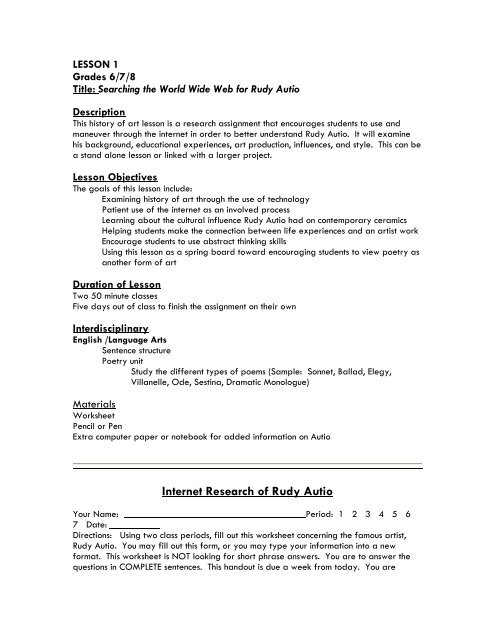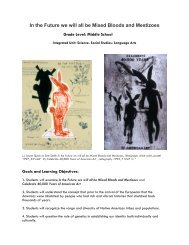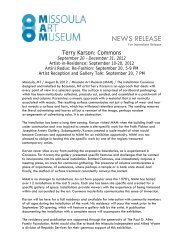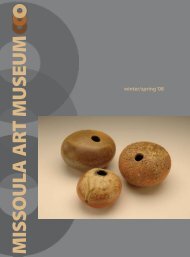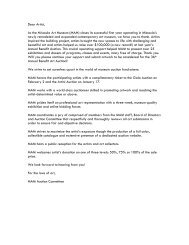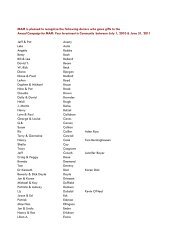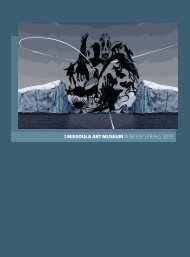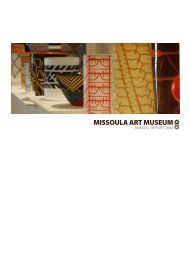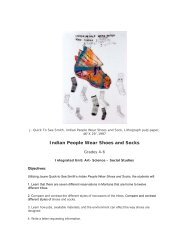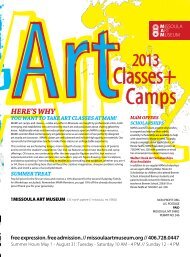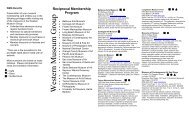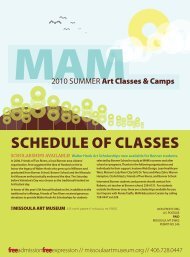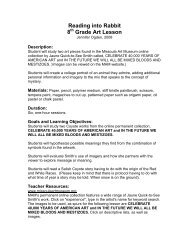Rudy Autio Lesson Plans - Missoula Art Museum
Rudy Autio Lesson Plans - Missoula Art Museum
Rudy Autio Lesson Plans - Missoula Art Museum
You also want an ePaper? Increase the reach of your titles
YUMPU automatically turns print PDFs into web optimized ePapers that Google loves.
LESSON 1<br />
Grades 6/7/8<br />
Title: Searching the World Wide Web for <strong>Rudy</strong> <strong>Autio</strong><br />
Description<br />
This history of art lesson is a research assignment that encourages students to use and<br />
maneuver through the internet in order to better understand <strong>Rudy</strong> <strong>Autio</strong>. It will examine<br />
his background, educational experiences, art production, influences, and style. This can be<br />
a stand alone lesson or linked with a larger project.<br />
<strong>Lesson</strong> Objectives<br />
The goals of this lesson include:<br />
Examining history of art through the use of technology<br />
Patient use of the internet as an involved process<br />
Learning about the cultural influence <strong>Rudy</strong> <strong>Autio</strong> had on contemporary ceramics<br />
Helping students make the connection between life experiences and an artist work<br />
Encourage students to use abstract thinking skills<br />
Using this lesson as a spring board toward encouraging students to view poetry as<br />
another form of art<br />
Duration of <strong>Lesson</strong><br />
Two 50 minute classes<br />
Five days out of class to finish the assignment on their own<br />
Interdisciplinary<br />
English /Language <strong>Art</strong>s<br />
Sentence structure<br />
Poetry unit<br />
Study the different types of poems (Sample: Sonnet, Ballad, Elegy,<br />
Villanelle, Ode, Sestina, Dramatic Monologue)<br />
Materials<br />
Worksheet<br />
Pencil or Pen<br />
Extra computer paper or notebook for added information on <strong>Autio</strong><br />
Internet Research of <strong>Rudy</strong> <strong>Autio</strong><br />
Your Name: Period: 1 2 3 4 5 6<br />
7 Date:<br />
Directions: Using two class periods, fill out this worksheet concerning the famous artist,<br />
<strong>Rudy</strong> <strong>Autio</strong>. You may fill out this form, or you may type your information into a new<br />
format. This worksheet is NOT looking for short phrase answers. You are to answer the<br />
questions in COMPLETE sentences. This handout is due a week from today. You are
allowed to work on this handout out of class, during library time, or at home. However,<br />
this is for you to fill out and is NOT a team or group assignment. You are to work on this<br />
SOLO. It is worth 25 points. (NOTE: The teacher can assign any type of point system<br />
to this handout depending on the overall point or grading system of the class.)<br />
Include hardcopy visual pictures of some of <strong>Autio</strong>’s works that you are focusing on for this<br />
worksheet.<br />
List the three websites you used the most to fill out this worksheet.<br />
Website #1 Address:<br />
Website #2 Address:<br />
Website #3 Address:<br />
Ceramic Sculptor’s Name:<br />
<strong>Rudy</strong> <strong>Autio</strong><br />
Date of Birth:<br />
Date of Death:<br />
Town and State of Origin:<br />
Educated Where:<br />
Practiced Where:<br />
Names of Most Famous Works:<br />
Favorite Medium Worked In:<br />
List of Different Media Worked In:<br />
<strong>Art</strong>ists that Influenced Your <strong>Art</strong>ist (list at least 6 artist):<br />
Most Common Method of Sculpting: Subtractive Additive<br />
(Circle One)
Why did you pick this type of <strong>Autio</strong>’s sculptures as one of your favorite Describe the<br />
difference in the diverse ways he sculpted.<br />
Describe <strong>Autio</strong>’s childhood<br />
What type of literary works was <strong>Autio</strong> interested in What did he enjoy reading and<br />
eventually created ceramic works based off of these mythical works<br />
What other materials did <strong>Autio</strong> create in List medium/media.<br />
How did <strong>Autio</strong> develop into his style For example, what changes did he go through in<br />
order to finally reach fame
What do you think <strong>Autio</strong> became famous Back up your belief with hard facts.<br />
How do you think this <strong>Autio</strong> changed the progression of ceramics<br />
When creating ceramics, what tools did <strong>Autio</strong> prefer using<br />
What other hobbies did <strong>Autio</strong> enjoy List at least 3 others)<br />
How was <strong>Autio</strong> influenced by the Works Progress Administration (WPA)<br />
Explain what is and how <strong>Autio</strong> was involved with the Archie Bray Foundation.
Why did <strong>Autio</strong> use images of human forms and horses in his artwork<br />
Extra Credit Question #1: What was <strong>Rudy</strong> <strong>Autio</strong>’s nickname in the ceramics world<br />
Extra Credit Question #2: What is the difference between ceramics as a craft compared<br />
to ceramics as an art<br />
Homework Assignment<br />
Directions: Choosing one of the stories you read about <strong>Autio</strong>, write a poem about <strong>Autio</strong><br />
and the narrative OR one of his artworks (attach the image to the poem if it is inspired by<br />
one of his works). Make sure you edit the poem as much as possible before you turn it in.<br />
This may become publishable. This is worth 25 points.<br />
Vocabulary<br />
Kiln<br />
Bisque and low firing<br />
Abstract Expressionism<br />
Places and Locations<br />
Butte, Montana<br />
WPA<br />
Archie Bray Foundation<br />
Flathead Lake<br />
Possible Follow-up Projects<br />
1. After all the student’s worksheets have been graded, review the questions in class<br />
as a group. The students enjoy this process and will learn additional information<br />
from their classmates. When conducting this review session, have available larger<br />
images of <strong>Autio</strong>’s work so the students can see concrete examples as answers to<br />
questions.
2. Have a guest poet visit your class to work with the students on editing their <strong>Autio</strong><br />
poems.<br />
3. Display the written poems at a local ceramics shop or art gallery. Or, you may<br />
consider have an evening or Saturday poetry reading at one of these places and<br />
invite friends, family and the public to the student reading.<br />
LESSON 2<br />
Grades: 7-8<br />
Title:<br />
<strong>Rudy</strong> <strong>Autio</strong>: Horses and People Clay Plate<br />
Description<br />
Each student will design a round 12” plate inspired by <strong>Rudy</strong> <strong>Autio</strong>’s circular wall plates.<br />
The design will include at least one human figure and one horse.<br />
<strong>Lesson</strong> Objectives<br />
The goals of this lesson include:<br />
Learning about <strong>Rudy</strong> <strong>Autio</strong> and his ceramic plates<br />
Using technology to complete gestured figure drawings of horses and people<br />
Manipulating preliminary sketches into a circular format<br />
Collaborative work ethics and knowledge while completing group work with a<br />
peer<br />
Understanding and completing all the steps involved in making a ceramic plate<br />
Learning how to glaze a vessel using a variety of glaze colors<br />
Duration of <strong>Lesson</strong><br />
(1 day = 50 minutes of instructional time)<br />
Introduction – 1 day (Possibly 1 more additional day for a visiting guest speaker)<br />
Drawing Exercise Lead-ups – 2 days<br />
Rolling out and slumping the clay plate – 2 days (1 day per student in a team of 2 kids)<br />
Sgrafitto design on wet clay plate – 1 day<br />
Addition of a clay foot and smoothing the bottom surface of the clay plate – 1 day<br />
Drying time – varies according to temperature (NOTE: Plan other activities during these<br />
days)<br />
Bisque Firing – 1 day to load, 1 day to fire, 1 day to cool<br />
Glazing – 2 to 3 days<br />
Low Firing - 1 day to load, 1 day to fire, 1 day to cool<br />
Materials<br />
1. Videos with horses and people in them<br />
2. Five sheets of 12x18 sheets of white drawing paper per student<br />
3. One small box of oil pastels per student<br />
4. Old dinner plate as close to a 12” size as possible
5. 1” strips of newspaper<br />
6. Small bowl of water<br />
7. Enough 24x24 pieces of canvas for students to roll out a clay slab (approximately<br />
12 pieces for a clay of 24)<br />
8. A rolling pin or large diameter wooden dowel (approximately 12 for a class of<br />
24)<br />
9. Five pounds of low fire clay (Archie Bray Sculpture Lowfire for a white color or<br />
Archie Bray ABF Earthenware Clay for red looking clay) per student<br />
10. Enough wooden strips about 1/2x12x2” to be used as braces to prevent the clay<br />
slab from getting too thin. (2 sticks per pair of students)<br />
11. Butter knife or fettling knife (1 per pair)<br />
12. Paper towels<br />
13. 24 Plastic garbage sacks (1 per student)<br />
14. Various clay or kitchen tools including a kitchen fork<br />
15. Low fire glazes (Amaco LUG Opaque Liquid Glaze)<br />
16. Electric kiln<br />
Instructional Strategies<br />
1. Introduction<br />
a. Present a history of <strong>Rudy</strong> <strong>Autio</strong>’s clay work on circular ceramic plates. At<br />
this time, you may want to include research on Peter Voulkos and Henri<br />
Matisse, since Voulkos was a close friend of <strong>Autio</strong> and who also made clay<br />
plates, but of a heavy nature. (See visual samples below) Also, Matisse<br />
would be good to study since his figurative designs are similar to <strong>Autio</strong>’s<br />
work.<br />
2. Drawing Exercises as Lead-ups<br />
a. Horse Video - Using a TV and DVDs, show the class movies concerning<br />
horses of various kinds. This could include horse races, rodeo, show, work,<br />
etc. (NOTE: Consult your local video store. An example could be Black<br />
Beauty.) You will just be using clips from these movies.<br />
b. Gesture Drawings of Horses - Give the students 5 sheets of 12x18<br />
drawing paper and oil pastels. Freeze the video for 5 minute intervals<br />
that show a horse or horses in action. Have the students sketch them as<br />
gestures. They should draw quickly and try to capture as much as possible.<br />
Contour line is important to emphasize. They may switch colors throughout<br />
the 5 minute sketch. Complete 5 different sketches.<br />
c. Gesture Drawings of People – Repeat the same exercise as above, but<br />
this time use people as the subject matter. You can draw on the back of<br />
the original 5 sheets of paper to conserve paper.<br />
3. Rolling Out the Clay and Building the Slump Vessel Plate<br />
a. It is helpful if the students work in pairs for this step. Each 2 kids will need<br />
the following materials: (an old dinner plate as close to a 12” size as<br />
possible, 1” strips of newspaper, small bowl of water, a 24x24 piece of<br />
canvas to roll the clay onto, a rolling pin or large diameter wooden dowel,<br />
about 5 pounds of low fire clay (Archie Bray Sculpture Lowfire for a white<br />
color or Archie Bray ABF Earthenware Clay for red looking clay).<br />
b. Cut up a section of a newspaper into 1” strips and individually dip the<br />
strips into the water bowl. Sliding off the excess water with your fingers,<br />
place the strip across the center of the plate (how about at the 12 o’clock
through 6 o’clock position.) Repeat this many times shifting the next strip of<br />
newspaper toward the 12:30 through 6:30 position). Repeat this step until<br />
the entire surface of the plate is layered with wet newspaper strips and no<br />
plate surface is showing. It is ok to overlap paper on paper.<br />
c. Next, place the 5 pound clay ball (make sure it is kneaded if it is not new<br />
clay straight from the “pre-pugged” clay brick shipped from Archie Bray)<br />
on top of the 24x24 piece of canvas on your table. Using two wooden<br />
sticks as “clay depth guides”, place one on the left side of the clay ball<br />
and the other one on the right side of the clay. Begin rolling out the clay<br />
as if rolling out a pie crust. Flip the flatten clay about every 15-30<br />
seconds to prevent the clay from sticking to the canvas. Try to roll the clay<br />
out so that it remains circular and NOT oval. Keep slab consistent in<br />
thickness. Once the rolling pin hits the clay sticks, it will be impossible to roll<br />
out the clay any thinner than 1/2” in depth.<br />
d. Slumping the clay onto the template plate - Carefully pick up the clay<br />
slab and drape it on the newspaper covered plate using this plate as a<br />
temporary mold. Take a butter knife or fettling knife and trim off the<br />
excess clay around the rim of the plate so the clay becomes the same size<br />
as the original old plate template.<br />
e. You can place a damp paper towel on top of the clay plate and cover it<br />
tightly with a plastic garbage sack in order to store the wet plate<br />
overnight. It is imperative to keep the plate damp and free of air pockets.<br />
4. Sgraffito Design – (the clay is still in the wet stage)<br />
a. Have the student pick their two best oil pastel drawings; one horse and one<br />
person design.<br />
b. Next, they are to lightly scratch these two best designs into the clays<br />
surface using a blunt pointed tool (such as a dull pencil tip, a ballpoint pen<br />
cap, or anything that won’t “cut” the clay like a knife blade would do).<br />
<strong>Rudy</strong> <strong>Autio</strong> used a brick layer’s trowel to draw his designs into the clay.<br />
The students can manipulate the design so that it better fits the circular<br />
format of the plate. (For example, arching backbones, curved horse faces,<br />
curved legs and arms, etc. See visual samples below) Only scratch into<br />
the surface about 1/16 to 1/8 of an inch in depth.<br />
c. Once the design is in place, use at least 4 textures within the positive and<br />
negative spaces. You can achieve this through the use of various clay and<br />
kitchen tools.<br />
5. Drying<br />
a. Slowly start to uncover the clay vessel in the next few days to allow air to<br />
slightly dry it out. Make sure the clay is not sticking to the original plate<br />
mold. You are waiting for the leather soft stage. Once the clay is firm<br />
enough, you can take it off the plate.<br />
b. Peel off the newspaper strips from the bottom and replace your plate<br />
upside down on the upside down original plate mold. Using your fingers,<br />
very light pressure, and a small amount of water, smooth out the<br />
newspaper embossed seams on the backside of the clay plate.<br />
Craftsmanship is important and if the piece were to break you cannot glue<br />
it together for a grade…you must reconstruct the entire piece.<br />
c. Foot - Roll out a coil about ½ inch diameter in size and 8 inches in length.<br />
Connect the two ends to make a circular clay ring. Place it on the back
side of the clay plate, trace around it lightly with a pencil, and remove it.<br />
Next, using a kitchen fork, score a circular ring on the plate where the<br />
pencil mark was traced which is proportional to the 8” clay ring. Also,<br />
score one side of the 8” clay ring. Attach the scored clay ring to the<br />
scored surface of the plate using slip. Lock into place. Smooth out.<br />
d. You can begin to open the sack up more each day. Let the clay dry slowly<br />
until it has reached the leather hard stage, then totally remove the plastic.<br />
e. Allow to dry to the bone dry stage. It is imperative NOT to touch the clay<br />
at all during this stage. Only the instructor should move the clay in order to<br />
load the kiln.<br />
6. Bisque Firing<br />
a. Fire the kiln at the recommended temperature according to your clay.<br />
Most low fire clays are fired at Cone 04, 05 or 06.<br />
7. Glazing<br />
a. First demo to students, then have them complete the following steps:<br />
i. how to rinse off the bisque vessel with water<br />
ii. Instilling Safety precautions when working with glaze….do not eat<br />
or drink around glaze. Wash equipment and hands thoroughly<br />
when finished using glazes. Do NOT cross contaminate from one<br />
glaze jar to the next using the same brush. (NOTE: After the clay<br />
pieces are fired, they are for display only and can not be used<br />
as dinnerware.)<br />
iii. Use old paintbrushes to paint on 3 layers of glaze to get proper<br />
saturation and coverage of glaze into the surface of the vessel.<br />
iv. Possibly have the students limit their colors to 3-5 so that they will<br />
tie together more. Even talk about color schemes that work well<br />
together.<br />
v. Make sure there is no glaze on the coil foot. If any glaze is<br />
touching the kiln shelf, it will adhere to the shelf during the low<br />
firing.<br />
8. Low Firing<br />
a. Fire the kiln at the recommended temperature according to the glazes.<br />
Amaco LUG Opaque Liquid Glaze is rated at Cone 04.<br />
<strong>Rudy</strong> <strong>Autio</strong>: Horses and People Clay Plate<br />
Grade Sheet<br />
Name: _______________________________ Period:<br />
Date : _____________<br />
Requirements<br />
Grades Possible Points Your Points<br />
Craftsmanship<br />
No cracking or breaking of structure 10<br />
Foot is attached well and has a streamline shape 5<br />
Design<br />
Creative 15<br />
Manipulation of preliminary sketch onto the front of plate 10
Effort<br />
Used 4 different textures 10<br />
Worked well with partner 5<br />
Finished on time 10<br />
Glaze quality<br />
Colors work well together 20<br />
Glaze has been applied with good workmanship 15<br />
TOTAL<br />
100 points<br />
Vocabulary<br />
Gesture drawing<br />
Contour line<br />
Slump Vessel<br />
Negative and positive space<br />
Wet Stage<br />
Leather Soft<br />
Leather Hard<br />
Bone Dry<br />
Bisque Firing<br />
Low Firing<br />
Embossed<br />
Score<br />
Slip<br />
Glaze<br />
Cone Temperature<br />
<strong>Art</strong>ist Influences<br />
Henri Matisse<br />
Peter Voulkos<br />
Websites<br />
Peter Voulkos – Voulkos & Co.<br />
http://www.voulkos.com/suprplatejpg.html<br />
Archie Bray Foundation for the Ceramic <strong>Art</strong>s<br />
http://www.archiebray.org/<br />
<strong>Art</strong> 106 Intro to Ceramics Sgrafitto<br />
http://seco.glendale.edu/ceramics/sgraffito.html<br />
Amaco Brent<br />
http://www.amaco.com/<br />
Resources for Teachers<br />
1. Possible Speakers<br />
a. Veterinarian – could address the physical structure of a horse<br />
b. Jockey – talk with the students about the occupation<br />
c. Trainer – Raising and training horses for different purposes
d. Rodeo Stunt Man – Handling horses under various conditions<br />
2. Talk with the librarian at your school for suggested readings that could go along<br />
with your project. (ie. Hope Rising)<br />
Possible Follow-up Projects<br />
1. Consider displaying the pieces at one of the following places:<br />
a. Gallery or ranch store<br />
b. Veterinarian facility<br />
c. Clay studio or ceramics shop<br />
d. University ceramics facility<br />
Examples of Clay Plates<br />
Peter Voulkos’ Untitled Plate, 1995, CR1168-W<br />
http://www.voulkos.com/suprplatejpg.html
Electra, Stoneware 1993, 28 inch diameter 3 inches deep, Collection of the artist<br />
http://www.rudyautio.com/<br />
<strong>Missoula</strong> <strong>Art</strong> <strong>Museum</strong>
Student Sgriffitto Plates<br />
LESSONS 3, 4, 5<br />
GRS. 6,7,8<br />
Title: <strong>Autio</strong> Inspirations : Using Slabs<br />
Description:<br />
Students will make clay and use slab techniques with inspiration from the works of <strong>Rudy</strong><br />
<strong>Autio</strong> . Using digital slides, the MAM archived website, posters and photos, students will<br />
review the clay works of <strong>Missoula</strong> artist <strong>Rudy</strong> <strong>Autio</strong>. When possible students will visit the<br />
closest art museum to see the works “for real” to get a good impression of the type of<br />
work he did and explore how he might have done it. (This is a good thing to do both<br />
before and after completing clay constructions. Students at all levels have a greater<br />
appreciation for how things might be done and complete an artist when they’ve had to try<br />
similar techniques.)<br />
Objectives<br />
a. Students will be familiar with the works of Montana artist <strong>Rudy</strong> <strong>Autio</strong>.<br />
b. Students’ skill development will proceed to slab construction.<br />
c. Students will discuss and evaluate the aesthetic value of their construction.<br />
Materials<br />
field trip access!<br />
low-fire clay (06 cone)<br />
clay tools<br />
buckets for slip<br />
clay board (flat board covered with canvas and two ½” sides made of wood)
olling pins<br />
paper towels<br />
6 th Grade:<br />
Title: Decorative Slab Vessels<br />
Procedure<br />
1. Using primarily slab construction, develop incisive drawings on three<br />
dimensional slab constructions completed as vessels, sculptures or both.<br />
2. Prepare clay using wedging technique.<br />
3. Roll out clay to approximately ½” thickness using hands or rolling pin<br />
with aid of clay board.<br />
4. Cut out two or three “sides” for sculpture, 4-6” tall and 4” at least at base.<br />
5. Cut out slab base so that sides will fit facing upward.<br />
6. Before scoring upright slabs and base, decide which side you want for<br />
outside and draw on it using pencil or clay tool. Also add texturing where<br />
desired. A preliminary drawing is helpful here in deciding what type of<br />
design works best on each side or is carried out around the entire surface.<br />
Imaginary or real animals are again a good theme. Be careful not to<br />
puncture holes in slab if making a vessel.<br />
7. Place slip on all “scored” (scratched) surfaces to be joined. Smooth and<br />
allow to dry.<br />
8. Touch up any areas on drawn surface. Paper towels or newspaper can be<br />
stuffed inside to strengthen shape while working on and drying the object.<br />
9. Bisque fire sculpture or vessel when completely dry.<br />
10. Underglaze/overglaze and fire again.<br />
7 th Grade:<br />
Title: Tile <strong>Art</strong> : Planning and designing your tile or tile mural:<br />
Description<br />
Display various examples of tiles and tile murals and discuss the use of tiles as decorative<br />
art as well as interpretive art, including size, shape and composition. (Note: the large<br />
mural at St. Anthony’s church on Tremont St. in <strong>Missoula</strong> is a good example of a large<br />
“relief” work or look around you town for other examples of tile murals)<br />
Either in small groups or as a class develop the overall tile design in the likeness of <strong>Rudy</strong><br />
<strong>Autio</strong>’s “horse” themes (http://www.rudyautio/work) or create an original design.<br />
Brainstorm as a group and develop an overall plan on paper. Be sure to determine size<br />
and shape as a whole and how to make the individual tiles work in the composition as a<br />
whole. If helpful, a grid the size of your overall design can be made on paper depending<br />
on your plan. In this case make<br />
overall paper the size of your entire drawing and divide into separate tile size and<br />
shape. Be sure your sizes are uniform.)<br />
Procedure:<br />
1. Discuss the procedure for developing a tile composition either<br />
as an individual or group project.<br />
2. Prepare the clay for tile making, i.e., wedging and even rolling.
(Again a handy tile thickness board can be made simply by covering<br />
a piece of wood with canvas cloth and bordering the two sides<br />
with even strips of wood about ½” thick.)<br />
3. Incise and texture individual tiles as desired or as agreed by<br />
group design plan.<br />
4. To incorporate raised areas of texture, pieces can be added on<br />
top of tile by scoring and adhering with slip. Be careful to<br />
attach thoroughly so no air pockets are trapped.<br />
5. Dry slowly and thoroughly (partially covering tiles), so that<br />
tiles do not buckle.<br />
6.. Bisque fire, glaze, and refire. Glue tiles to a board to achieve<br />
overall design for vertical view, or glue and grout for flat display/<br />
Eighth Grade:<br />
Title: Dig it!<br />
Description:<br />
Making clay from raw materials (optional/additional assignment, as requires collecting<br />
actual dirt clay from probable off school site, but it’s really fun to put together. (groups of<br />
4 work best). Making clay from local natural resources is something <strong>Rudy</strong> <strong>Autio</strong> and local<br />
artists did/do frequently. A visit to the Archie Bray clay studio in Helena is a fantastic<br />
experience for students as they can see the original manufacturing of clay as well as<br />
artists’ uses of the material.<br />
Procedure:<br />
1. Collect clay from previously designated sites, perhaps with the help of<br />
local artists or Forest Service soils personnel. Sometimes clay can even be found<br />
below the surface in your own yard or garden. A little research from local artists<br />
as well as Forest Service personnel can reveal
many local sites .roads, particularly where the road has been dug out. (Large soap buckets work well as<br />
they are light and often have lids.) Half a bucket works well, per group. Another bucket is needed per<br />
group for water. )<br />
2. Using old window screen cut to size of bucket top, sift dirt into second<br />
bucket so that all sticks and rocks are freed from dirt. (Have extra dirt<br />
in case original amount is not enough.)<br />
3.. Allow dirt to sit in water and stir often with heavy stick (old wooden<br />
handles work well.)<br />
4. Sift again into the second bucket to refine dirt/clay.<br />
5.. Depending on the type of dirt, this process may need to be repeated<br />
over several days.<br />
6. Allow water to evaporate and then remove clay and begin working with<br />
hands. Wedge as possible, keeping moist with “slip” (clay/water mixture)<br />
7. Work clay until a good finished ball (or not!) is formed.<br />
8. Evaluate success of clay forming and its elasticity.<br />
9.Make something quite simple from the clay, i.e., pinch pot, etc., and low<br />
fire to see if successful.<br />
.<br />
Time<br />
Ongoing classroom group project, set aside time and place for continuous stirring, etc. Total time, not<br />
including collection of dirt, which could be done as homework, would be 1-2 hours, divided into 15-30<br />
minute segments.<br />
Montana Content Standards for <strong>Art</strong><br />
Standard 2 Students apply and describe the concepts, structures and processes in<br />
art.<br />
Standard 3 Students develop and refine art skills and techniques to express ideas,<br />
pose and solve problems, and discover meaning.<br />
Standard 4 Students analyze characteristics and merits of their work.<br />
Standard 5 Students understand the role of art in society, diverse cultures, and<br />
historical periods.


